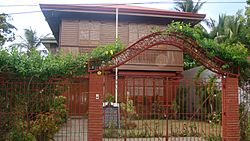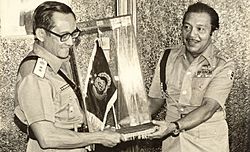Fidel V. Ramos facts for kids
Quick facts for kids
Fidel V. Ramos
|
|
|---|---|
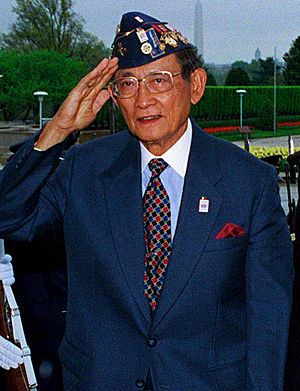
Ramos in 1998
|
|
| 12th President of the Philippines | |
| In office June 30, 1992 – June 30, 1998 |
|
| Vice President | Joseph Estrada |
| Preceded by | Corazon C. Aquino |
| Succeeded by | Joseph Estrada |
| 17th Secretary of National Defense | |
| In office January 22, 1988 – July 18, 1991 |
|
| President | Corazon Aquino |
| Preceded by | Rafael Ileto |
| Succeeded by | Renato de Villa |
| 19th Chief of Staff of the Armed Forces of the Philippines | |
| In office February 25, 1986 – January 21, 1988 |
|
| President | Corazon Aquino |
| Preceded by | Fabian Ver |
| Succeeded by | Renato de Villa |
| In office October 24, 1984 – December 2, 1985 |
|
| President | Ferdinand Marcos |
| Preceded by | Fabian Ver |
| Succeeded by | Fabian Ver |
| Chief of the Philippine Constabulary | |
| In office 1972 – February 25, 1986 |
|
| President | Ferdinand Marcos |
| Preceded by | Eduardo M. Garcia |
| Succeeded by | Renato de Villa |
| Personal details | |
| Born |
Fidel Valdez Ramos
March 18, 1928 Lingayen, Pangasinan, Philippine Islands |
| Died | July 31, 2022 (aged 94) Makati, Philippines |
| Resting place | Libingan ng mga Bayani Taguig, Philippines |
| Political party | Lakas–Kampi–CMD/Lakas–CMD (2008–2022) |
| Other political affiliations |
Lakas–NUCD (1991–2008) LDP (1991) |
| Spouse | |
| Children | 5 (including Cristy) |
| Residences | Asingan, Pangasinan Ayala Alabang, Muntinlupa |
| Alma mater | United States Military Academy (BS) University of Illinois at Urbana-Champaign (MS) National Defense College of the Philippines (MNSA) Ateneo de Manila University (MBA) |
| Occupation | Soldier Civil engineer |
| Awards |
See awards
Philippine Legion of Honor |
| Signature | |
| Website | Official website: http://www.rpdev.org/ Office of the PresidentArchived |
| Nicknames | Eddie, FVR |
| Military service | |
| Allegiance | |
| Years of service | 1950–1988 |
| Rank | |
| Commands |
See commands
Platoon Leader, 2nd Battalion Combat Team (BCT), Counter-Insurgency against the Communist Hukbalahap, 1951 |
| Battles/wars | Hukbalahap Campaign Korean War, 1951–1952 (Battle of Hill Eerie, May 1952) Vietnam War, 1965 to 1968Battle of Marawi, 1972 |
Fidel Valdez Ramos (born March 18, 1928 – died July 31, 2022), also known as FVR or Eddie Ramos, was a Filipino general and politician. He served as the 12th president of the Philippines from 1992 to 1998. He was the only military officer to become a five-star general and then commander-in-chief.
Ramos was praised for helping the Philippine economy grow and for bringing back international trust in the country during his six years as president. He was the third oldest person to become president. Before becoming president, Ramos was a high-ranking officer in the Philippine military. He became Chief of the Philippine Constabulary and Vice Chief-of-Staff of the Armed Forces of the Philippines under President Ferdinand Marcos.
During the 1986 EDSA People Power Revolution, many Filipinos saw Ramos as a hero. He decided to leave the Marcos government and support the new government of President Corazon Aquino. After the revolution, Ramos worked in President Aquino's cabinet. He was the chief-of-staff of the Armed Forces of the Philippines (AFP) and later the Secretary of National Defense from 1986 to 1991. He helped create the Philippine Army's Special Forces and the Philippine National Police Special Action Force. After retiring from the military, he stayed active in politics, advising later presidents. He passed away at 94 due to complications from COVID-19.
Contents
Early Life and Education
Fidel Valdez Ramos was born on March 18, 1928, in Lingayen, Pangasinan. He grew up in Asingan town. His father, Narciso Ramos (1900–1986), was a lawyer, journalist, and a five-time member of the House of Representatives. He later became the Secretary of Foreign Affairs. Narciso Ramos signed the ASEAN declaration in 1967 and was a founder of the Liberal Party. Fidel's mother, Angela Valdez (1905–1978), was a teacher and a woman suffragette. She was related to former President Ferdinand E. Marcos.
Fidel went to elementary school in Lingayen. He started high school at the University of the Philippines High School in Manila. He then continued at the High School Department of Mapúa Institute of Technology. He finished high school at Centro Escolar University Integrated School in 1945.
After high school, he went to the United States. He was accepted into the United States Military Academy at West Point, where he earned a Bachelor of Science degree in Military Engineering. He also got a master's degree in civil engineering from the University of Illinois. In 1953, he took the Civil Engineering Board Exam and placed 8th. He also held master's degrees in National Security Administration and Business Administration. He received 29 honorary doctorate degrees during his life.
Marriage and Family Life
He married Amelita Martinez on October 21, 1954, in Manila. They had five daughters: Angelita, Josephine, Carolina, Cristina, and Gloria. They also had five grandsons and three granddaughters.
Military Career and Service
Early Military Service
Ramos graduated from the United States Military Academy at West Point in 1950. During his time in the Philippine Army, he started the Philippine Army Special Forces. Later, he became the commander of the Army's 3rd Division in Cebu City.
Ramos received many military awards. These include the Philippine Legion of Honor, the Distinguished Conduct Star, and the Distinguished Service Star. He also received the Philippine Military Merit Medal and the U.S. Military Academy Distinguished Graduate Award.
Korean War Service
Ramos was part of the Philippines' 20th Battalion Combat Team. This team fought in the Korean War as part of the Philippine Expeditionary Forces to Korea (PEFTOK). He was an Infantry Reconnaissance Platoon Leader. Ramos was a hero in the Battle of Hill Eerie, where he led his platoon to surprise the enemy.
Vietnam War Service
Ramos also served in the Vietnam War. He was a non-combat civil military engineer and Chief of Staff of the Philippine Civic Action Group (PHILCAG). During this time, he became good friends with Maj. Jose T. Almonte, who later became his National Security Advisor when Ramos was president.
Martial Law Period
In January 1972, Ramos was made head of the Philippine Constabulary. This was the country's national police force at the time. He held this position when Ferdinand Marcos declared Martial Law on September 21, 1972.
As head of the Philippine Constabulary, Ramos was in charge of the Command for the Administration of Detainees (CAD). This group handled the arrest and detention of political prisoners during the Marcos era. Ramos also helped close down media outlets when Martial Law was declared. He later said that his role in the EDSA Revolution was his way of making up for his part in Martial Law.
Role in the EDSA Revolution
On February 22, 1986, Defense Minister Juan Ponce Enrile spoke out against alleged fraud in the 1986 snap elections. He withdrew his support for Marcos, which started the peaceful People Power Revolution. General Ramos also joined Enrile at Camp Crame. They both pledged their loyalty to Corazón Aquino, the widow of Senator Benigno Aquino.
On February 25, the "EDSA Revolution" reached its peak. Marcos, his family, and some supporters left the country with help from the United States government. This ended his 20-year rule. Corazon Aquino then became the country's first female President.
Chief of Staff and Defense Secretary
After Corazon Aquino became President, she appointed Ramos as Chief of Staff of the Armed Forces of the Philippines (1986–1988). Later, he became Secretary of National Defense and Chairman of the National Disaster Coordinating Council (1988–1991). In these roles, he managed the government's response to disasters like the 1990 Luzon earthquake and the 1991 eruption of Mount Pinatubo.
During this time, Ramos personally led military operations that stopped nine coup attempts against the Aquino government.
1992 Presidential Election
In December 1991, Ramos announced he would run for president. However, he did not get the nomination from his party, the Laban ng Demokratikong Pilipino (LDP). He then started his own party, the Partido Lakas Tao (People Power Party). He chose Cebu Governor Emilio Mario Osmeña as his running mate.
Ramos won the election on May 11, 1992. He narrowly defeated Miriam Defensor Santiago. His running mate, Governor Osmeña, lost the vice-presidential race to Joseph Estrada. Ramos won with 23.58% of the vote, which was the lowest percentage for a winning president in the country's history. There were claims of fraud, but the Supreme Court dismissed the protest.
Presidency (1992–1998)
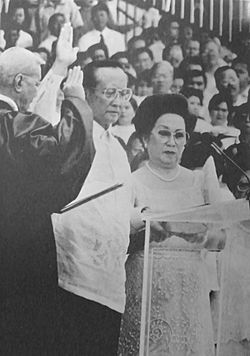
| Presidential styles of Fidel V. Ramos |
|
|---|---|
 |
|
| Reference style | His Excellency |
| Spoken style | Your Excellency |
| Alternative style | Mr. President |
When he became president in 1992, Ramos was the first and only Protestant president in the mostly Roman Catholic country. He was also the only Filipino officer to have held every rank in the military, from Second Lieutenant to Commander-in-Chief.
His first three years as president saw economic growth, new technologies, political stability, and better basic services for people. He was the first Christian Democrat president in the Philippines. He was also an important leader and unofficial spokesperson for liberal democracy in Asia.
Domestic Policies and Programs
Philippines 2000 Vision
Ramos' main plan for the country was called "Philippines 2000". This plan aimed for the Philippines to become a newly industrialized country by the year 2000.
The program had five main goals:
- Peace and Stability
- Economic Growth and Lasting Development
- Energy and Power Generation
- Protecting the Environment
- Making Government Work Better
Peace with Armed Groups
Even though he was a former general, Ramos worked for peace with different rebel groups in the country. He started by creating a National Unification Commission (NUC).
Ramos was key in signing a peace agreement between the government and the Moro National Liberation Front (MNLF) in 1996. He also signed a law that made membership in the Communist Party of the Philippines legal again. This law repealed the Anti-Subversion Law.
Economic Improvements
| Population | |
|---|---|
| 1992 |  63.82 million 63.82 million |
| Gross Domestic Product (constant 1985 prices) | |
| 1992 | |
| 1997 | |
| Growth rate, 1992–1998 average | 4.9% |
| Per capita income (constant 1985 prices) | |
| 1992 | |
| 1997 | |
| Total exports | |
| 1992 | |
| 1997 | |
| Exchange rates | |
| 1 US$ = Ph₱ 29.47 1 Ph₱ = US$ 0.034 |
|
| Sources: FIDEL V. RAMOS |
|
Ramos started economic reforms to open up the country's economy. He wanted to encourage private businesses and attract more foreign and local investments. He also worked to reduce corruption. Ramos traveled a lot to other countries, bringing in about US$20 billion in foreign investments. He hosted the 4th Asia Pacific Economic Cooperation (APEC) Leaders' Summit in 1996 to show a positive financial outlook for the Philippines.
Under his leadership, the Philippines saw economic growth and stability. The Philippine Stock Exchange was one of the best in the world in the mid-1990s. His "Philippines 2000" vision helped the country become a "Tiger Cub Economy in Asia."
Solving the Power Crisis
When Ramos became president, the Philippines had many blackouts. This was because there was a high demand for electricity, power plants were old, and some energy projects were stopped earlier. Ramos asked the Congress to create an Energy Department to manage the country's energy needs. Congress gave him special emergency powers to fix the power crisis.
Ramos allowed private companies to build power plants quickly. He signed contracts that guaranteed the government would buy the power these companies produced. This helped attract investments. The Philippines was a pioneer in the Build-Operate-Transfer (BOT) scheme. This allowed private investors to build government projects like power plants and earn money from them before transferring them to the government.
Death Penalty Reinstatement
During his campaign for president, Ramos supported bringing back the death penalty. It had been abolished in 1987. After his presidency, some people were put to death, but the death penalty was abolished again in 2006.
Foreign Policies and Relations
Spratly Islands Issue
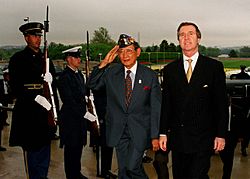
In 1995, the Philippines found a Chinese military structure on Mischief Reef in the Spratly Islands. This reef was close to Palawan. The Philippine government protested this and arrested Chinese fishermen. Ramos ordered the military to strengthen its forces in the area. China said the structures were for fishermen, but these events could have led to conflict in the South China Sea.
Protecting Migrant Workers
A big challenge for his administration was protecting Filipino migrant workers abroad. Millions of Filipinos work in other countries, and their money sent home is very important to the Philippine economy. On March 17, 1995, a Filipino worker named Flor Contemplación was executed in Singapore. Ramos tried to negotiate, but it was too late. This led to protests in Manila and the resignation of some cabinet members. Ramos recalled the Philippine ambassador to Singapore and temporarily stopped diplomatic relations.
To address this, Ramos created a special commission. Based on its recommendations, he helped pass Republic Act No. 8042, known as the "Magna Carta for Overseas Workers" or the Migrant Workers Act, in June 1995. This law aimed to protect Filipino workers abroad. After tensions eased, Ramos restored diplomatic relations with Singapore.
1997 Asian Financial Crisis
The 1997 Asian Financial Crisis, which began in Thailand, greatly affected the end of Ramos' presidency. The economy faced currency devaluation, with the Philippine Peso dropping significantly. Economic growth slowed down, and some businesses closed. This led to a rise in unemployment and an unstable financial sector.
Charter Change Efforts
During his last years in office, Ramos tried to change the country's 1987 constitution. This process was called "charter change" or cha-cha. Large protests, led by Corazon Aquino and the Roman Catholic Church, stopped him from going forward with the plan.
After the Presidency (1998–2022)
Later Activities
EDSA II Revolution
In January 2001, Ramos played an important role in the Second EDSA Revolution. This event removed President Joseph Estrada from office and put then-Vice President Gloria Macapagal Arroyo in power.
Ramos was the Chairman Emeritus of the Lakas CMD party. In July 2005, during an election-rigging scandal, Ramos publicly urged President Gloria Macapagal Arroyo not to resign. He said the scandal was not as serious as the People Power Revolutions of 1986 and 2001.
Advocacies and Roles
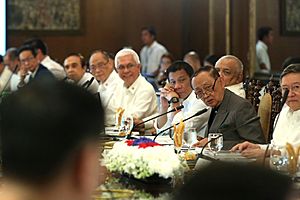
Ramos also proposed changes to the country's constitution. He believed these changes were needed to make the country more competitive economically and improve governance. He supported changing the political system to a unicameral parliament, moving towards a federal system.
Ramos represented the Philippines in the ASEAN Eminent Persons Group. This group was tasked with writing the Charter of the Association of South East Asian Nations (ASEAN). He was also a member of many international groups. He was the chairman of the Board of Directors of the Boao Forum for Asia.
Ramos was a strong supporter of the proposed Philippine Reproductive Health bill. He urged President Benigno Aquino III to make the bill urgent. During his presidency, the Department of Health under Juan Flavier promoted family planning.
Ramos Peace and Development Foundation
After his presidency, Ramos started the Ramos Foundation for Peace and Development (RPDEV). This foundation is a non-profit organization that works to promote peace and development in the Philippines and the Asia-Pacific region. RPDEV supports Philippine national interests and helps empower people.
Philippine Envoy to China

In June 2016, President-elect Rodrigo Duterte said that Ramos encouraged him to run for president. On July 23, 2016, President Duterte appointed Ramos as the Philippine Envoy to China. This was to improve relations between the two countries after disagreements over the South China Sea.
However, on November 1, 2016, Ramos resigned from the post. He said he had misjudged the effects of a Duterte presidency. President Duterte accepted his resignation. Ramos continued to support President Duterte but also voiced concerns and criticisms about his administration.
COVID-19 Pandemic Period
During the COVID-19 pandemic in the Philippines, Ramos stayed under strict home quarantine. He kept up with the latest news, including the pandemic. On June 25, 2021, he received his second dose of the COVID-19 vaccine in Ayala Alabang, Muntinlupa.
On March 18, 2022, for Ramos' 94th birthday, the Fidel V. Ramos Presidential Library was launched online. It became the first and only online presidential library in the Philippines. It was later known that Ramos was already ill at this time.
2022 Elections
During the 2022 elections, Ramos did not publicly endorse a candidate. However, he had pledged support for the presidential campaign of Leni Robredo. He had also supported her successful vice-presidential campaign in 2016.
Death
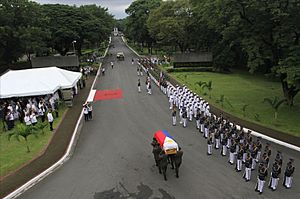
Fidel V. Ramos passed away on July 31, 2022, at 94 years old, at Makati Medical Center. His family announced that he died from complications related to COVID-19. They also confirmed he had a heart condition and dementia.
President Bongbong Marcos declared July 31 to August 9 as "national days of mourning". During this time, all national flags were flown at half-mast as a sign of respect. Ramos' remains were cremated, making him the second Philippine president to be cremated before burial. His wake was held from August 4–8. On August 9, he received a state funeral. His remains were placed at the Libingan ng mga Bayani in Taguig.
Approval Ratings
| Date | Rating |
|---|---|
| Sep 1992 | +66 |
| Dec 1992 | +60 |
| Apr 1993 | +66 |
| Jul 1993 | +69 |
| Sep 1993 | +62 |
| Dec 1993 | +65 |
| Apr 1994 | +67 |
| Aug 1994 | +55 |
| Nov 1994 | +49 |
| Dec 1994 | +50 |
| Mar 1995 | +24 |
| Jun 1995 | +26 |
| Oct 1995 | +1 |
| Dec 1995 | +2 |
| Apr 1996 | +17 |
| Jun 1996 | +19 |
| Sep 1996 | +21 |
| Dec 1996 | +24 |
| Apr 1997 | +50 |
| Jun 1997 | +49 |
| Sep 1997 | +35 |
| Dec 1997 | +40 |
| Jan 1998 | +13 |
| Feb 1998 | +20 |
| Mar 1998 | +15 |
| Mar–Apr 1998 | +30 |
| Apr 1998 | +19 |
| Average | +38 |
Honors and Decorations
National Honors
 : Commander of the Philippine Legion of Honor (March 18, 1988, and July 19, 1991)
: Commander of the Philippine Legion of Honor (March 18, 1988, and July 19, 1991) : Knight Grand Cross of the Order of the Knights of Rizal.
: Knight Grand Cross of the Order of the Knights of Rizal.- Rizal Pro Patria Award (June 22, 1993)
Military Medals (Philippines)
 : Military Merit Medal (May 23, 1952)
: Military Merit Medal (May 23, 1952) : Distinguished Service Star (May 20, 1966, December 20, 1967, and August 3, 1981)
: Distinguished Service Star (May 20, 1966, December 20, 1967, and August 3, 1981) : Military Commendation Medal (May 31, 1968)
: Military Commendation Medal (May 31, 1968): Outstanding Achievement Medal (July 29, 1983)
 : Distinguished Conduct Star (January 14, 1991)
: Distinguished Conduct Star (January 14, 1991) : AFP Long Service Medal
: AFP Long Service Medal Korean Campaign Medal
Korean Campaign Medal Vietnam Service Medal
Vietnam Service Medal Disaster Relief & Rehabilitation Operation Ribbon
Disaster Relief & Rehabilitation Operation Ribbon
Military Medals (Foreign)
 : Cheonsu Medal, Order of National Security Merit (South Korea)
: Cheonsu Medal, Order of National Security Merit (South Korea) : United Nations Service Medal (United Nations)
: United Nations Service Medal (United Nations) : Commander, Legion of Merit (United States)
: Commander, Legion of Merit (United States)
Foreign Honors
 Brunei:
Brunei:
 Chile:
Chile:
 France:
France:
 Grand Cross of the Order of Legion of Honour
Grand Cross of the Order of Legion of Honour
 Indonesia:
Indonesia:
 Malaysia:
Malaysia:
 Pakistan:
Pakistan:
 Nishan-e-Pakistan (March 8, 1997)
Nishan-e-Pakistan (March 8, 1997)
 Peru:
Peru:
 Spain:
Spain:
 Collar of the Order of Civil Merit (September 2, 1994)
Collar of the Order of Civil Merit (September 2, 1994) Collar of the Order of Isabella the Catholic (March 24, 1995)
Collar of the Order of Isabella the Catholic (March 24, 1995) Collar of the Order of Charles III (January 30, 1998)
Collar of the Order of Charles III (January 30, 1998)
 South Korea:
South Korea:
 Thailand:
Thailand:
 United Kingdom:
United Kingdom:
 Honorary Knight Grand Cross of the Most Distinguished Order of St. Michael and St. George (1995)
Honorary Knight Grand Cross of the Most Distinguished Order of St. Michael and St. George (1995)
International Organizations
- Bronze Wolf Award (July 28, 1993)
See also
 In Spanish: Fidel V. Ramos para niños
In Spanish: Fidel V. Ramos para niños


